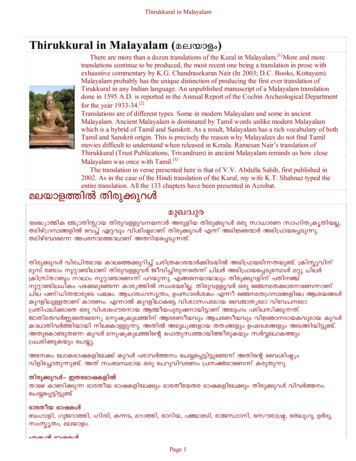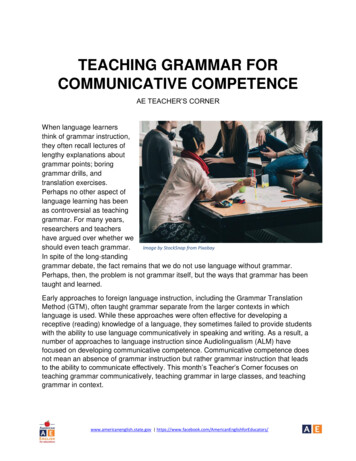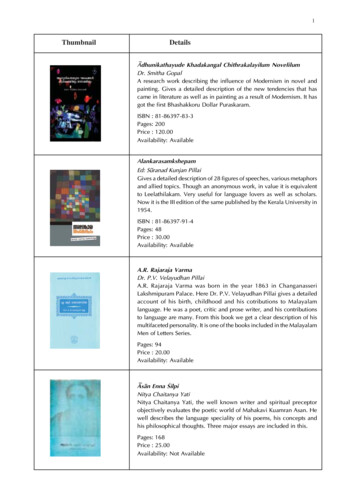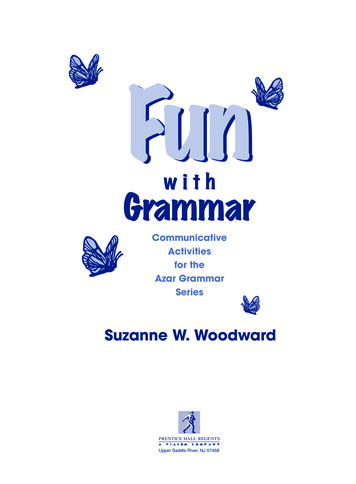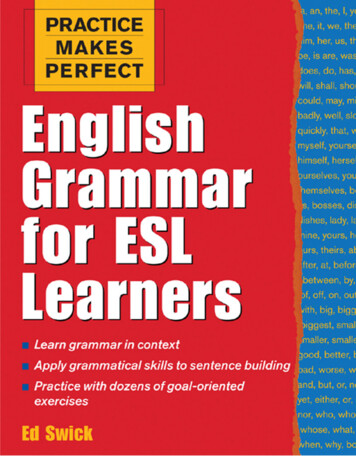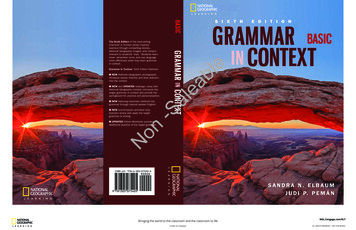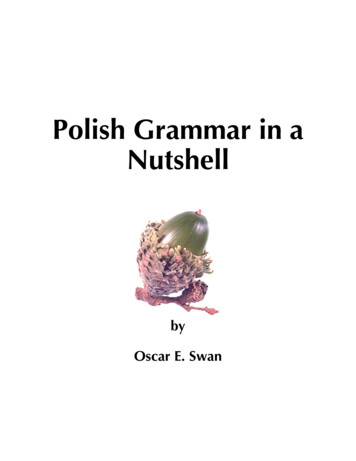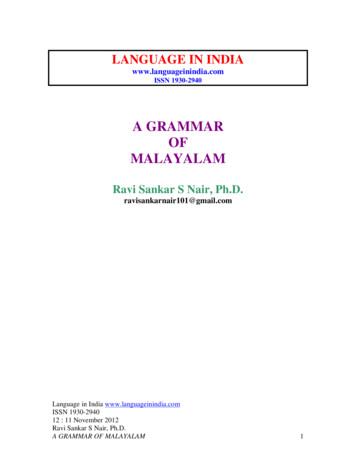
Transcription
LANGUAGE IN INDIAwww.languageinindia.comISSN 1930-2940A GRAMMAROFMALAYALAMRavi Sankar S Nair, Ph.D.ravisankarnair101@gmail.comLanguage in India www.languageinindia.comISSN 1930-294012 : 11 November 2012Ravi Sankar S Nair, Ph.D.A GRAMMAR OF MALAYALAM1
PrefaceThe grammatical tradition in Malayalam, compared to the three other major Dravidianlanguages, is neither extensive nor ancient. Liilaatilakam, dated to the closing years of14th century, is generally considered as the earliest treatise referring to grammaticalstructures of Malayalam. This, however, is not a work of grammar as such, but dealsmainly with rhetoric as applied to Man ipr avaal am, the literary language that was anadmixture of Malayalam and Sanskrit.Except some brief treatises in Portuguese, Latin and English authored by missionaries, upto 19th century Malayalam did not have a proper grammar. Hermann Gundert’s Malayal abhas aa vyaakaran am first published in 1851 and the revised and enlarged version comingout in 1868 was the first proper grammatical treatise of Malayalam. Rev. GeorgeMathen’s Malayaalmayut e vyaakaran am (1863), Pachu Mootthatu’s Keeral abhaas aavyaakaran am, A.R Rajaraaja Varma’s Keeral a paan iniyam (originally published in 1896;revised and enlarged edition in 1917) and M. Seshagiri Prabhu’s Vyaakaran amitram(1904) followed.Grammatical literature from this point of time was essentially focused on Keeral apaan iniiyam, which came to enjoy almost the status of an ‘authorised grammar’ ofMalayalam.While Rajaraja Varma’s work stands out by its breadth of coverage and scholarship, itcannot be denied that grammatical tradition in Malayalam has remained too long withinthe ambit of a grammar written nearly a century back. A common grammatical traditiondrawing on various grammars failed to evolve and consequently the framework ofKeeral a paan iniiyam continued as the sole grammatical model in Malayalam. Thegrammars written in the post- Keeral a paan iniiyam period are essentially explanatorytreatises on Keeral a paan iniiyam.While a few grammarians have suggested alternative analyses in some areas, thegrammars themselves faithfully follow the basic framework of Rajaraja Varma. For aperiod of more than 80 years from Keeral a paan iniiyam, no grammarian attempted eitherto extend the Keeral a paan iniyam model to produce a more comprehensive treatment ofMalayalam or to analyze the grammatical structure of Malayalam using alternativemodels of grammatical description. Keeral a paan iniyam and other traditional grammarshave extensively covered the morphology of the language. However, there is preciouslittle in them about syntax and semantics.Having to deal with the structure of a modern language like Malayalam using a restrictedgrammatical model has had serious repercussions in many fields. Researchers in thefields of Computational Linguistics, speech pathology and language teaching very oftenlament the absence of a more modern and comprehensive grammar of Malayalam,especially one that adequately covers syntactic and semantic aspects.Language in India www.languageinindia.comISSN 1930-294012 : 11 November 2012Ravi Sankar S Nair, Ph.D.A GRAMMAR OF MALAYALAM2
From the 1960’s researchers in modern linguistics have published in many journalspertinent analyses on various aspects of Malayalam grammar. A modern full-fledgedgrammar of Malayalam was however, not attempted until 1997 when Asher and Kumaripublished Malayalam under the Descriptive Grammars series edited by Bernard Comrie.This work represents the most comprehensive and in-depth coverage of Malayalamavailable. Syntax, morphology and phonology of Malayalam are extensively covereddrawing on the traditional views as well as modern linguistic analyses. The lacunae in thetraditional grammatical description has, however, not been entirely cleared up. Varioussyntactic and semantic features associated with categories and structures of Malayalamremained to be analyzed.Vaakyadarśanam of Ravi Sankar S. Nair (2011) was an attempt in this direction. Basiccategories and structures of Malayalam are defined and described in this work, followedby analyses of the syntactic and semantic features of each. The various sentencestructures and word formation mechanisms are also analyzed.The present work draws on Vaakyadarśanam. The first three chapters on Noun, Verband Modifiers describe the semantic and syntactic features of each of these word classes.The sub-categories are extensively classified. The last chapter provides a description ofthe different sentence types in Malayalam.AcknowledgementsThe author is deeply indebted to the late Prof. Somasekharan Nair (formerly Professor,Department of Linguistics, University of Kerala) for encouragement and advice duringthe early stages of the preparation of Vaakyadarśanam, from which the present work isdrawn. Late Prof. A. P. Andrewskutty and Prof E. V. N Namboodiri (both from theDepartment of Linguistics, University of Kerala) offered insightful comments on theMalayalam version. I am grateful to Dr. Vijayendra Bhas and Dr. Kumari Nirmala, mycolleagues in the Hadramouth University of Science and Technology, for support andconstant encouragement.DedicationDedicated to the young men and women of the Republic of Yemen, who lost their lives intheir struggle against an authoritarian regime in their country, during the early months of2011 when the final version of this book was being written in the city of Seiyun inYemen where I was teaching.Ravi Sankar S Nair10 October 2012Language in India www.languageinindia.comISSN 1930-294012 : 11 November 2012Ravi Sankar S Nair, Ph.D.A GRAMMAR OF MALAYALAM3
CONTENTS1. NOUN1 .1 Case System1 .1.1 Introduction1 .1.2 Nominative1 .1.3 Accusative1 .1.4 Dative1 .1.5 Sociative1 .1.6 Instrumental1 .1.7 Locative1.3 Number and gender1.4 Pronoun1.4.1 Introduction1.4.2 Personal pronouns1.4.3 Reflexive pronouns1.4.4 Interrogative pronouns1.4.5 Possessive pronouns1.4.6 Indefinite pronouns2. VERB2.0 Classification of verbs2.1 Finite verbs2.1.1 Stative verbs2.1.1.1 Conjunctive verb aak2.1.1.2Meanings denoted by aak2.1.1.3 aak as lexical verb2.1.1.4 Cleft constructions2.1.1.5 Aspectual form2.1.1.6 Emphasizing different elements2.1.1.2 Conjunctive verb un t ǔ2.1.2.1Meanings denoted by un t ǔ2.1.2.2Aspectual usage2.1.2.3Differences between aak and un t ǔ2.1.1.3 Participial forms of conjunctive verbsLanguage in India www.languageinindia.comISSN 1930-294012 : 11 November 2012Ravi Sankar S Nair, Ph.D.A GRAMMAR OF MALAYALAM4
2.1.3.12.1.3.2IntroductionVerbal participle of aak2.1.1.4 Negative forms2.1.1.5 Interrogative forms2.1.2 Action Verbs2.1. 2.1 Tense2.1.2.1.1 Past tense2.1.2.1.2 Present tense2.1.2.1.3 Future tense2.1.2.2 Aspect2.1.2.2.1 Progressive aspect2.1.2.2.1. 1.1 Uses of progressive aspect2.1.2.2.1.1.2 Infinitive aan ǔ2.1.2.2.2. Iterative aspect2.1.2.2.3 Emphatic iterative aspect2.1.2.2.4 Perfect aspect2.1.2.2.4.1 Simple perfect2.1.2.2.4.2 Contemporaneous perfect2.1.2.2.4.3 Remote perfect2.1.2.2.5 Habitual aspect2.1.2.3 Mood2.1.2.3.1 Imperative mood2.1.2.3.2 Compulsive mood2.1.2.3.3 Negative compulsive mood2.1.2.3.4 Promissive mood2.1.2.3.5 Permissive mood2.1.2.3.6 Optative mood2.1.2.3.7 Precative mood2.1.2.3.8 Negative precative mood2.1.2.3.9 Desiderative mood2.1.2.3.10 Abilitative mood2.1.2.3.11 Irrealis mood2.1.2.3.12 Dubitative mood2.1.2.3.13 Purposive mood2.1.2.3.14 Conditional mood2.1.2.3.15 Satisfactive mood2.1.2.3.16 Monitory mood2.1.2.4 Epistemic modality2.1.2.4.1 Evidential and judgemental modality2.1.2.4.2 Forms of evidential mood2.1.2.5 Negation2.1.2.6 InterrogationLanguage in India www.languageinindia.comISSN 1930-294012 : 11 November 2012Ravi Sankar S Nair, Ph.D.A GRAMMAR OF MALAYALAM5
2.1.1.7 Passive verb2.2 Non-finite verb2.2.1 Infinitive form2.2.2 Purposive infinitive2.2.3 Obligative infinitive2.2.4 Simultaneous infinitive3 MODIFIERS3.1 Adjectives3.1.1 Types of adjectives3.1.1.1 Relative participle form3.1.1.2 Noun Participle of copula verbs3.1.1.3 Genitive form of nouns3.1.1.4 Locative copula3.1.1.5 Free adjectives3.1.1.5.1 Characteristics of free adjectives3.1.1.5.2 Classification of free adjectives3.1.1.5.2.1 Adjectival bases3.1.1.5.2.2 Quantifiers3.1.1.5.2.3 Adjectival modifiers3.1.1.5.2.4 Intensifiers3.1.1. 5.2.5 Enumeratives3.1.1.5.2.6 Determiners3.1.2 Coordination of adjectives3.2 Adverbs3.2.1 Characteristics of adverbs3.2.2 Classification of adverbs3.2.2.1 Manner adverbs3.2.2.2 Locative adverbs3.2.2.3 Temporal adverbs3.2. 2.4 Sequential adverbs3.2.2.5 Sentential adverbs3.2.2.6 Comparative adverbs3.2. 2.7 Repetitive adverbs3.2.2.8 Interactive adverbs3.2.2.9 Directional adverbs3.2.2.10 Quantifying adverbs3.2.2.11 Indefinitive adverbs3.2. 2.12 Emphatic adverbsLanguage in India www.languageinindia.comISSN 1930-294012 : 11 November 2012Ravi Sankar S Nair, Ph.D.A GRAMMAR OF MALAYALAM6
3.2.2.13 Inclusive adverbs3.2. 2.14 Degree adverbs3.2.2.15 Progressive adverbs3.2. 2.16 Free forms3.2.3 Reduplication of adverbs3.2.4 Coordination of adverbs3.3 Postpositions3.3.1 Introduction3.3.2 Postpositions following all cases3.3.3 Postpositions following nominative case3.3.4 Postpositions following accusative case3.3.5 Postpositions following dative case4. SENTENCE4.1 Coordination4.1.1Coordination through the dummy verb cey4.1.2 Coordination through ‘either---- or’4.1.3Coordination through ‘atoo’4.1.4 Coordination through ‘paks e’4.1.5 Coordination through ‘ennaal’4.2 Subordination4.2.1 Nominal clause4.2.2 Adjective clause4.2.3 Adverbial clause4.2. 3.1 Temporal clause4.2.3.2 Perfective clause4.2.3.3 Contemporaneous clause4.2.3.4 Instantaneous clause4.2.3.5 Conclusive clause4.2.3.6 Manner clause4.2.3.6.1Participial form of aak4.2.3.6.2 Locative noun4.2.3.6.3 Manner clause with postposition4.2.3.7 Comitative clause4.2.3.8 Purpose clause4.2.3.8.1 Infinitive form4.2.3.8.2 Infinitive aak4.2.3.8.3 Purposive meaning through postpositionLanguage in India www.languageinindia.comISSN 1930-294012 : 11 November 2012Ravi Sankar S Nair, Ph.D.A GRAMMAR OF MALAYALAM7
4.2.3. 8.4 Participial atu aa4.2.3.9 Cause clause4.2.3.9.1 Causative meaning through postposition4.2.3.10 Condition clause4.2.3.10.1 Unfulfilled condition4.2.3.11 Concession clause4.2.3.11.1 Negative concession clause4.2.3.12 Alternative condition-concession clause4.2.3.12.1 Coordination through participle -um/ -oo4.2.3 .12.2 Coordination through aay -um/ -oo4.3 Quotative Clause4.4 Coordination through ennu -um / -oo4.5 Interrogative sentences4.5.1 Neutral Yes-No questions4.5.2 Alternative questions4.5.3 Questioning of individual elements4.5.4 Question word question4.5.5 E-question4.6 Exclamatory sentencesAbbreviationsABLT AbilitativeACC Accusative caseADVB AdverbialCAUS CausativeCOMP ComparativeCOND ConditionalCONJ ConjunctiveCONT ContinuousCONTEM ContemporaneousDAT Dative CaseDES DesiderativeDESD DesiderativeDIR OBJ Direct ObjectDISJ DisjunctiveDUB DubitativeEMPH EmphaticEXCL ExclamatoryFEM FeminineFUT Future TenseGEN GenitiveLanguage in India www.languageinindia.comISSN 1930-294012 : 11 November 2012Ravi Sankar S Nair, Ph.D.A GRAMMAR OF MALAYALAMHAB HabitualHONR HonorificHORT HortativeIMP ImperativeINDEF IndefinitiveINDIR OBJ Indirect ObjectINFN InfinitiveINST InstrumentalINST InstrumentalINTER InterrogativeIRLS IrrealisITER IterativeLOC COP Locative CopulaLOC LocativeMASC MasculineNEG NegativeNMNL NominalNON FIN Non FiniteOBLG ObligativeOPT OptativePASS Passive8
PAST Past TensePCPL ParticiplePERF PerfectivePERM PermissivePERM PermissivePL PluralPOSS PossibilitivePREC PrecativePRES Present TensePROB ProbabilitivePROMS PromissiveLanguage in India www.languageinindia.comISSN 1930-294012 : 11 November 2012Ravi Sankar S Nair, Ph.D.A GRAMMAR OF MALAYALAMPURP INFN Purposive InfinitiveQT Quotative MoodQUOT QuotativeREFL ReflexiveREMO RemoteRP Relative ParticipleRPT ReportiveSATS SatisfactiveSOC SociativeVOC Vocative9
CHAPTER INoun1.1 The Case System1.1.1 IntroductionMalayalam follows the system of marking grammatical relations and semantic rolesthrough a set of case suffixes, a feature common to the Dravidian languages. As roles andrelations are conveyed through suffixes, word order changes do not normally altersentence meaning in Malayalam.The case system of Malayalam includes six cases; nominative, accusative, dativesociative, instrumental and locative. The suffixes for each are listed umentalLocativeSuffixф-e-kku, -ŭ-oot ŭ-aal-il, -attŭThe major classical grammars of Malayalam, following the Sanskrit grammaticaltradition, treat the genitive as a case. However, syntactic evidence supports the contraryview. All other cases in Malayalam are based on noun-verb relations. The genitive nounremains outside the basic sentence structure. The genitive noun does not have a directsemantic or grammatical relation with the verb but only the noun modified by thegenitive is related to the verb. Because of this, the genitive noun can be removed from thesentence without affecting the grammaticality of the sentence. [cf. enr e makan skuul ilpat hikkunnu ‘my son is studying in school’ and makan skuul il pat hikkunnu ‘Son isstudying in the school’] For these reasons, the genitive is not treated as a case here.The case suffixes are capable of conveying different shades of meaning over and abovethe basic grammatical meaning. The subject is in the dative case in all of the followingsentences; the semantic relation between the noun and the verb is however different ineach of them.(1) enikkŭ taruuI-DATgive-IMP‘Give to me’Language in India www.languageinindia.comISSN 1930-294012 : 11 November 2012Ravi Sankar S Nair, Ph.D.A GRAMMAR OF MALAYALAM10
(2) enikkŭ manassilaayiI-DAT understand-PAST‘I understood’(3) enikkŭ ar iyaamI-DAT know-DESD‘I know’(4) enikkŭ veen amI-DAT need‘I want’(5) enikkŭ pani aan ŭI-DAT fever be-PRES‘I have fever’A clear distinction between core cases, which relate more deeply with the sentencestructure and peripheral case which are linked rather weakly to the sentence structure isevident in Malayalam.Nominative, accusative, dative and sociative cases link the nouns to the basic structure ofthe sentence. When these nouns are removed the sentence becomes ungrammatical orsemantically defective. Instrumental and locative nouns can be removed from thesentence without affecting the grammaticality of the sentence. Nominative, accusative,dative and sociative can be treated as core cases and the remaining two as peripheralcases. The meanings conveyed by core cases cannot be conveyed through other cases orpostpositions. The meanings of peripheral cases, in many instances can be conveyedthrough other cases or postpositions. [E.g. veedanayaal / veedana kon t u pul aññu.‘Writhed in pain’ talayil / talaykkŭ at iccu ‘Hit on the head’. The grammatical andsemantic meaning conveyed by each of the core case is definite and limited. Themeanings conveyed by the peripheral cases are varied and diffuse.Each case suffix can take a number of postpositions, introducing a range of meanings.(6) enikkŭI-DAT‘For me’(7) enikku maatramI-DAT only‘Only for me’(8) enikkŭ veen t iI-DAT for‘For my sake’(9) enikkŭ poolumI-DAT even‘Even for me’Language in India www.languageinindia.comISSN 1930-294012 : 11 November 2012Ravi Sankar S Nair, Ph.D.A GRAMMAR OF MALAYALAM11
The system of case is the most important exponent of the grammar of the noun. The basicconstruction of the sentence is determined by the case system. Each case imposes certainselection restrictions on the verb by being linked to semantic classes of verbs orgrammatical forms of verbs.(10) itilninnŭ nii entu manassilaakki?this-LOC from you what understand-TRANS-PAST(11) itilninnŭ ninakkŭ entu manassilaayi?this-LOC fromyou-DAT what understand-INTR-PASTWhat did you understand from this’The first sentence takes the verb in its transitive form (aak) and the second takes theintransitive form (aay). Though the sentences have basically the same meaning, the twoverb forms cannot be interchanged. This difference is brought about by the fact that thenominative noun has an agentive meaning while the dative cannot be an agent. Thenominative is typically related to intransitive verbs, while the accusative does not acceptintransitive verbs.(12a) raaman ciriccu ‘Raman smiled’(12b) *raamane ciriccuThe sociative takes only verbs of interaction like, discuss, enquire, speak etc. Benefactiveverbs require dative subjects. Imperative forms of verbs require nominative subjects andpermissive forms are always linked to dative subjects.(13) nii poo ‘You go’(14) ninakku pookaam ‘You may go’How the core cases differ in grammatical roles and relations is shown in the table below.Distribution of grammatical relations and semantic roles across the core cases.CASESGrammaticalRelationsSemantic ct -Object -Language in India www.languageinindia.comISSN 1930-294012 : 11 November 2012Ravi Sankar S Nair, Ph.D.A GRAMMAR OF MALAYALAMExperiencerPatient - -Recipient 12
1.1.2 Nominative.The nominative noun denotes the subject of the sentence.(15) ravi elutiRavi write-PAST‘Ravi wrote’(16) kaar r u viiśiWindblow-PAST‘ Wind blew’(17) aval pookunnuShe go-PRES‘She is going’(18) ayaal enne oor kkumheI-ACC remember-FUT‘He will remember me.’The subject can be marked by the dative also, but only in sentences where there is noagentive noun.(19) siitaykkŭ pan am kit t iSita-DAT money get-PAST‘Sita got the money’(20) aval kkŭ saŋkat am aayiShe-DAT sadnessbe-PAST‘She became sad’(21) avanŭ koopam varumHe-DAT angercome-FUT‘He will get angry’In sentences where both nominative and dative nouns are present, the dative can functiononly as the indirect object.(22) goovindan jamiilaykkŭ pan am nalki.GovindanJamila-DAT moneygive-PAST‘Govindan gave money to Jamila’(23) nii avanŭ koopam varuttiYou he-DAT angercome -CAUS-PASTLanguage in India www.languageinindia.comISSN 1930-294012 : 11 November 2012Ravi Sankar S Nair, Ph.D.A GRAMMAR OF MALAYALAM13
‘You made him angry’1.1.2 The nominative functions in the role of agent and experiencer. Nominative nounsthat are subjects of transitive verbs are agents and those of intransitive verbs areexperiencers. Agent.(24) aval avanesneehiccuShe he-ACC love-PAST‘She loved him’(25) joon makane mat iyil iruttumJohnson-ACC lap-LOC sit-FUT‘John will seat (his) son on (his) lap’ Experiencer(26) enr e sneehitan bhiiruvaayirunnuI-GEN friendcoward-be-PAST‘My friend was a coward’(27) elsi karaññuElsy cry-PAST‘Elsy cried’1.1.3 AccusativeAccusative marks the object of the sentence.(28) appu tattayepit iccuAppu parrot-ACC catch-PAST‘Appu caught (a) parrot’(29) ñaan raamaneIavit e kan t uRaman-ACC there see-PAST‘I saw Raman there’(30) aval induvine vil ikkunnusheIndu-ACC call-PRES‘She is calling Indu’In sentences where there is a nominative, accusative and dative noun, the nominative willbe the subject, the accusative the direct object and the dative, the indirect object.Language in India www.languageinindia.comISSN 1930-294012 : 11 November 2012Ravi Sankar S Nair, Ph.D.A GRAMMAR OF MALAYALAM14
(31) jooseph tanr etattayeliilaykkŭnalki(DIR OBJ) (INDIR OBJ)Joseph I-REFL-POSS parrot-ACC Lila-DATgive-PAST‘Joseph gave his parrot to Lila.’Accusative functions as the patient that can be concrete or abstract.(32) śivan ayaal e at iccuSivan he-ACC beat-PAST‘Sivan beat him’(33) śivan ayaal e aaraadhiccuSivanhe-ACC worship-PAST‘Sivan worshipped him’Accusative is typically linked to transitive verbs. It also occurs with causative form of theverb.(34) deevan sahoodariye aaśvasippiccuDevansister-ACCconsle-PAST‘Devan consoled (his) sister’(35) aval enne karayiccusheI-ACC cry-CAUS-PAST‘She made me cry’The accusative marks the object in sentences with a conjunctive verb and a dativesubject.(36) addeehatte enikku viśvaasam aan ŭhe-ACCI-DAT trustbe-PRES‘I have trust in him’(37) jayaykkŭ raamuvine is t am allaJaya-DAT Ramu-ACC likebe-NEG-PRES‘Jaya does not like Ramu’Accusative marks the focal word in comparative constructions.(38) avanekkaal um mit ukkan ivit e illa.He-ACC-COMPsmart man here be-NEG‘There is none smarter than him here.’(39) avaneppoole vid d hiyalla ñaan.He-ACC- COMP fool-BE-NEG I‘I am not a fool like him’Language in India www.languageinindia.comISSN 1930-294012 : 11 November 2012Ravi Sankar S Nair, Ph.D.A GRAMMAR OF MALAYALAM15
The accusative suffix is usually dropped in a sentence where the subject- objectdistinction is otherwise clear.(40) pan ikkaar maram mur ikkunnuWorkerstreecut-PRES‘The workers are cutting the tree’(41) avar paar a pot t iccuThey rockbreak-PAST‘They cleaved the rock’The accusative suffix is mandatory when the agent is inanimate and the patient animate,and when both are inanimate.(42) mala aval enanaccuRain she-ACC drench-PAST‘The rain drenched her’(44) maram cet ikal eTreemar aykkunnuplants-ACC hide-PRES‘The plants are hidden by the tree’A sentence with abstract nouns for both subject and object will become semanticallyambiguous if the accusative suffix is not used to mark the object. For example (45) hastwo interpretations; the noun taking the accusative becomes the object and the meaningchanges accordingly as in (45a) and (45b).(45) maunam teet unna vaakkŭSilencesearch-PRES-RP word(45a) maunatte teet unnavaakkŭSilence-ACC search-PRES-RP word‘The word in search of silence’(45b) vaakkine teet unnamaunamWord-ACC search-PRES-RP silence‘Silence in search of the word’In sentences involving a factitive semantic role, (i.e., the noun is an object that comesinto existence as the result of the action denoted by the verb) the accusative does notmark the object.Language in India www.languageinindia.comISSN 1930-294012 : 11 November 2012Ravi Sankar S Nair, Ph.D.A GRAMMAR OF MALAYALAM16
(46) ravi meeša un t aakkiravi tablemake-PAST‘Ravi made a table’(47) us a katha elutumUsha story write-FUT‘Usha will write a story’(48) mantri pr samgam aarambhiccuminister speechbegin-PAST‘The minister began (the) speech’1.1.4 DativeThe dative case noun can stand as either subject or object. In sentences where there isno nominative noun, the dative functions as the subject.(49)aval kkŭ raamuvine viśvaasam illaShe-DAT Ramu-ACC trustbe-NEG‘She has no trust in Ramu’(50) addeehattinŭ kaaryam manassilaayi.He-DATmatterunderstand-PAST‘He understood the matter’(51) satiykkŭ pet t annŭ dees yam varumSati-DAT suddenly angercome-FUT‘Sati gets angry easily’In sentences with both nominative and dative nouns, the latter functions as the indirectobject.(52) ñaan atŭ meeriykkŭ kot ukkumIthat Mary-DATgive-FUT‘I will give that to Mary’(53) aays a avar kkŭ katha par aññukot uttuAyshathey-DAT story say-give-PAST‘Aysha told them stories’The dative subject functions in the grammatical role of experiencer while the dativeobject is benefactive. Like the accusative, the dative also does not perform the agentiverole. Dative provides the scope for forming sentences without agent. The differenceLanguage in India www.languageinindia.comISSN 1930-294012 : 11 November 2012Ravi Sankar S Nair, Ph.D.A GRAMMAR OF MALAYALAM17
between nominative subject and dative subject is based on this. Consider sentences (54)and (55).(54) aval kkŭ dees yam vannuShe-DAT angercome-PAST‘She got angry’(55) raviykkŭ pan am kit t iRavi-DAT money get-PAST‘Ravi got money’The dative subject in these sentences is conceived as the recipient or beneficiary of anaction performed by an unknown or unspecified subject. In the first sentence, anger‘comes’ (vannu ‘came’) to the subject without the conscious volition of the subject and inthe second sentence, an unspecified agent performs an action which results in the subjectcoming into possession of money.The verbs of dative nouns cannot be made into imperative forms unlike nominative,accusative and sociative nouns.(56) raamanŭ aval oot ŭ sneeham toonni * aval oot u sneeham toonnŭRamanshe-SOC lovefeel-PAST‘Raman felt love for her’(57) ayaal kkŭ viśvaasam aayi *viśvaasam aakŭHebeliefbe-PAST‘He was convinced’(58) enikkŭ karaccil varum *karaccil varŭI-DATcrycome-FUT‘I will feel like crying’However, as in other case forms, the verb governed by a dative noun can be made intooptative forms.(59) avanŭ aval oot ŭ sneeham toonnat t e.he-DAT she-SOC lovefeel-OPT‘Let him feel love for her’(60) aval kku viśvaasam aakat t eShe-DAT beliefbe-OPT‘Let him believe’(61) avanu dees yam varat t eHe-DAT angercome-OPT‘Let him get angry’Language in India www.languageinindia.comISSN 1930-294012 : 11 November 2012Ravi Sankar S Nair, Ph.D.A GRAMMAR OF MALAYALAM18
Dative also marks the complement.(62) rameesan śastr akr iiyakku vidheeyanaayiRamesan surgery-DATsubject-be-PAST‘Ramesan underwent (was subjected) to surgery’(63) iiprakhyaapanam samarattinu kaaran amaayiThis announcementstrike-DATreason-be-PAST‘This announcement became the reason for the strike’(64) avarut e aavaśyaŋŋal kkŭ sar kkaar valaŋŋunnillatheir-GEN demands-DATgovernment concede-not-PRES‘The government is not conceding their demands’The dative can convey a wide range of meanings over and above the grammaticalmeaning.Benefactive meaning is the basic sense contained in dative constructions andconsequently the dative noun occurs most frequently with benefactive verbs.(65) mantri udyoogasthar kku nir deeśam nalkiministerofficers-DATdirectiongive-PAST‘The minister gave directions to the officers’(66) aa ar ivŭenikkŭ aaśvaasam tannirunnuthat knowledge I-DAT consolation give-PAST-PERF‘That knowledge gave consolation to me’(67) aval kkŭ dharaal am pan am kit t umshe-DAT muchmoneyget-FUT‘She will get a lot of money’The dative case copula constructions convey the meaning of ‘state of being’ or achange in state.(68) avar kkŭ peet i aan ŭthey-DAT fearbe-PRES‘They are afraid’(69) aliykkŭ ennot ŭ koopam un t ŭAli-DAT I-SOCangerbe-PRES‘Ali is angry with me’Language in India www.languageinindia.comISSN 1930-294012 : 11 November 2012Ravi Sankar S Nair, Ph.D.A GRAMMAR OF MALAYALAM19
(70) bhuumiykkŭ vayassaakunnuearth-DATage be-PRES-CONT‘The earth is getting older’Dative is used to express needs and demands.(71) enikkŭ caaya veen amI-DATteaneed‘I want tea’(72) ii raajyattinŭ moocanam kit t an amthis country-DAT liberation get-DES‘This country needs liberation’(73) aval kkŭ pookan amshe-DAT go-DES‘She wants to go’Verbs of perception take the dative subject.(74) enikkŭ oru nalla man am anubhavappet unnuI-DAT one good smellexperience-PRES‘I feel a nice smell’(75) avanŭ koopam toonni.he-DAT angerfeel-PAST‘He felt angry’(76) jamiilaykkŭ saŋkat am vannuJamila-DATsadnesscome-PAST‘Jamila felt sad’Verbs denoting ability take the dative subject.(77) pariiks ayiljayikkaan avanŭ kaliññillaExamination-LOC pass-INFN he-DAT be-able-PAST-NEG‘He was not able to pass the exam.’(78) harikkŭ imgl iis samsaarikkan par r unnillaHari-DAT English speak-INFNbe-able-NEG‘Hari is not able to speak English’Language in India www.languageinindia.comISSN 1930-294012 : 11 November 2012Ravi Sankar S Nair, Ph.D.A GRAMMAR OF MALAYALAM20
A common use of the dative is to convey the meaning of ‘for’.(79) oru nissaara kur r attinŭ aval śiks ikkappet t uone pettyoffence-DAT she punish-PASS-PAST‘She was punished for a petty offence’(80) ii sahaayattinŭ janaŋŋal aŋŋayoot ŭ kat appet t irikkunnuthis help-DATpeopleyou-SOCindebted-PASS-PRES-CONT‘The people are indebted to you for this help’(81) lailayut e śr amaŋŋal kkŭ phalamun t aayiLaila-GEN efforts-DATresult-be-PAST‘Laila’s efforts’ had (a) result’With the conjunctive verb ‘un t ŭ’ and its negative form, dative denotes possessivemeaning.(82) avanŭ pani un t ŭhe-DAT fever be-PRES‘He has fever’(83) ñaŋŋal kkŭ vidyaabhyaasam illawe-DATeducationbe-NEG-PRES‘We do not have education’ [we are not educated](84) enikkŭ tiir cca un t ŭI-DATsurety be-PRES‘I am sure’(85) citr aykkŭ putiya paavaat a un t ŭChitra-DAT newskirtbe-PRES‘Chitra has a new skirt’(86) achanŭennil viśvaasam un t ŭfather-DAT I-LOC trustbe-PRES‘Father has trust in me’(87) ivar kkŭ oru nalla kaar un t ŭthey-DAT one goodcarbe-PRES‘These people have a good car’The dative is commonly used to convey spatial and temporal meaning.(88) ñaan eelŭ man ikkŭ ur aŋŋumIseven time-DAT sleep-FUTLanguage in India www.languageinindia.comISSN 1930-294012 : 11 November 2012Ravi Sankar S Nair, Ph.D.A GRAMMAR OF MALAYALAM21
‘I will sleep at seven o’ clock’(89) adhyaapakar et t u muppatinŭ skuul ilteacher-PLettan ameight thirty-DAT school-LOC reach-DES‘Teachers must reach the school at eight thirty’(90) d ookt ar uccaykkŭdoctorvarumafternoon-DAT come-FUT‘The doctor will come in the afternoon’(91) vijayam aval ut e talaykkŭ pit iccuvictoryshe-GEN head-DAT catch-PAST‘Victory has gone to her head’The dative also denotes genitive meaning.(92) talykkŭ pinnil( talayut e pinnil )head-DAT behind-LOChead-GEN behind-LOC‘Behind (the) head’(93) mur iykkŭ pur attŭ( mur iyut e pur attŭ )room-DAT outsideroom-GEN outside‘Outside the room’1.1.5 SociativeThe sociative is grammatically similar to the accusative but semantically different. Likethe accusative, the sociative also marks the objective.(94) luukkoos annayoot ŭ aa vaar tta par aññuLukoseAnna-SOC that newstell-PAST‘Lukose told that news to Anna’(95) varaamooennu hamiidinoot u coodikkŭcome-PROM-INTER QOTHamid-SOCask-IMP‘Ask Hamid if (he) can come’The sociative nouns do not function in the role of experiencer but only as recipients. Asentence with sociative object cannot be passivized.Language in India www.languageinindia.comISSN 1930-294012 : 11 November 2012Ravi Sankar S Nair, Ph.D.A GRAMMAR OF MALAYALAM22
(96) mantri udyoogastaroot ŭ par aññu *mantriyaal par ayappet t a udyoogastar minister officers-SOCsay-PAST‘The minister told the officers’The sociative noun denotes the passive recipient or passive participant of action. Itappears in two types of constructions. In the first type the noun is directly linked to theverb.(97) nal ini pan ikkaaroot ŭ kayar kkukaNalini workers-SOCaayirunnuargue-NON FI
Except some brief treatises in Portuguese, Latin and English authored by missionaries, up to 19th century Malayalam did not have a proper grammar. Hermann Gundert's Malayal a bhas aa vyaakaran am first published in 1851 and the revised and enlarged version coming out in 1868 was the first proper grammatical treatise of Malayalam. Rev. George
